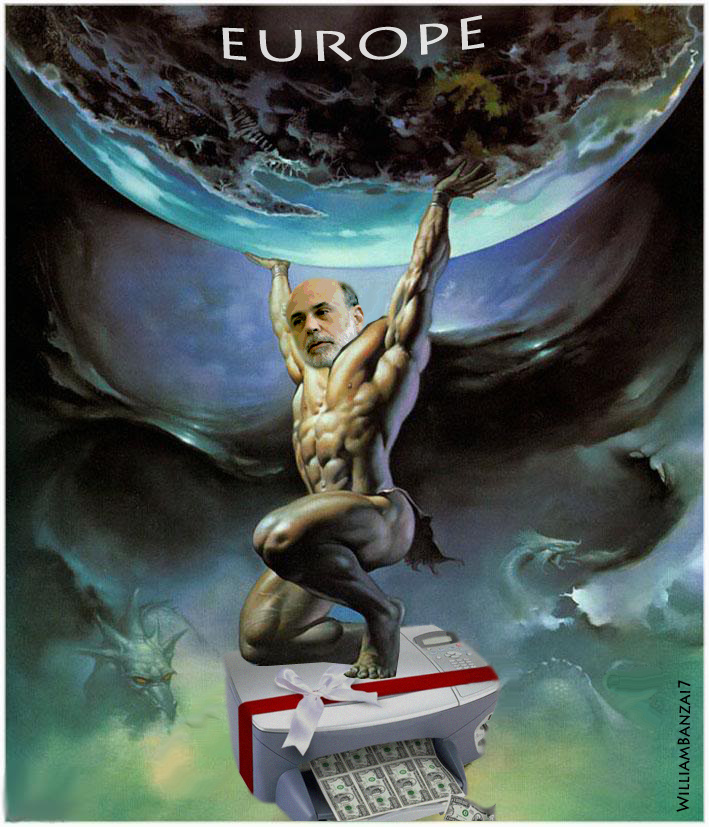Courtesy of Mish
 Steen Jakobsen, chief economist for Saxo Bank offers his take on the liquidity moves by global central bankers.
Steen Jakobsen, chief economist for Saxo Bank offers his take on the liquidity moves by global central bankers.
Please consider Steen’s Chronicle, Maximum Intervention Moves Into Overdrive
Our theme for Q4 was ‘Maximum Intervention’ and today was a new high for this exact concept. The day after the European Union Finance Ministers (ECO-FIN) meeting (which once again failed to produce any progress on the EU debt crisis) the Chinese cut the RRR-ratio – the minimum reserves each commercial bank must hold of customer deposits and notes – from 21.5 percent to 21.0 percent. (The RRR started the year in 18.5 percent and this is the first cut since 2008. Back in 2006 the RRR ratio was just below 8.0 percent for a number of years.) This is an indication that China’s help to the growing outlook of a ‘Perfect Storm’ will be monetary easing despite relatively stubborn inflation numbers.
Coup-de-grace
Then in coup-de-grace style the Federal Reserve and five other major central banks cut the dollar funding rate for overnight swaps by 50 basis points, down from 100 basis points, and at the same time made this programme run through to February 2013.This immediately raises the hope for further cuts in policy rates in the US and Europe. Right now, foreign banks can fund themselves cheaper in US Dollars than US banks. This will almost certainly mean the discount rate will be cut by 25 bps and before the weekend.Mounting pressure on Monti
The market loves liquidity and this action shows the true determination of policymakers to address the growing funding crisis, but its ultimate success will depend on progress in the EU debt crisis, and whether this will again merely be a stand-alone action of throwing liquidity at a problem which remains one of solvency. In other words, the lack of structural changes in Europe – are the same both before and after this coordinated intervention. Alas, technocrat Monti remains more important to the future of this risk-on move than the move itself.However, it should not be ignored that the market is looking for excuses to take the S&P 500 index higher, and there is no denial that the underlying economic data from the US has continuously surprised to the upside over the past month. Fundamentals are improving in the US, and the ADM report this morning gave indications that Non-Farm Pay-Rolls data on Friday could yet be another positive news story.
‘Monster Santa’ rally
Earlier this week I described this week as likely to be one of consolidation and potential for a rest at 1215/1220 – we have now clearly overshot this on the upside and the target 1240/50 might well be in full view. The market also likes the “seasonal play” of buying into year-end, and I am getting plenty of ammunition from tech-based analysts that the price action reminds them of September/October 2010 – the post Jackson Hole rally – making this the start of a ‘monster Santa’ rally.I will remain sidelined with a negative bias, if only because, my generic models are short, and from a tactical point of view, I feel that to get a real solution to solvency, unlike liquidity, we need to see stock markets in mini-crash mode before politicians and policymakers truly understand the necessity to make a long-term commitment to austerity and growth. The signal today was: We are prepared to buy more time, and feel confident enough to float the market with cheap liquidity and an indication of further easing to come. The market will love that, but investors should also remember to stay sober when drinking from the cool-aid name: cheap money.
Go Santa,
Safe travels!
Discount Rate Discussion
The Federal Reserve website has this discussion of the Discount Rate.
The discount rate is the interest rate charged to commercial banks and other depository institutions on loans they receive from their regional Federal Reserve Bank’s lending facility–the discount window. The Federal Reserve Banks offer three discount window programs to depository institutions: primary credit, secondary credit, and seasonal credit, each with its own interest rate. All discount window loans are fully secured.
Under the primary credit program, loans are extended for a very short term (usually overnight) to depository institutions in generally sound financial condition. Depository institutions that are not eligible for primary credit may apply for secondary credit to meet short-term liquidity needs or to resolve severe financial difficulties. Seasonal credit is extended to relatively small depository institutions that have recurring intra-year fluctuations in funding needs, such as banks in agricultural or seasonal resort communities.
The discount rate charged for primary credit (the primary credit rate) is set above the usual level of short-term market interest rates. (Because primary credit is the Federal Reserve’s main discount window program, the Federal Reserve at times uses the term "discount rate" to mean the primary credit rate.) The discount rate on secondary credit is above the rate on primary credit. The discount rate for seasonal credit is an average of selected market rates. Discount rates are established by each Reserve Bank’s board of directors, subject to the review and determination of the Board of Governors of the Federal Reserve System. The discount rates for the three lending programs are the same across all Reserve Banks except on days around a change in the rate.
Further information on the discount window, including interest rates, is available from the Federal Reserve System’s discount window web site.
Discount Window
Pic credit: William Banzai7



